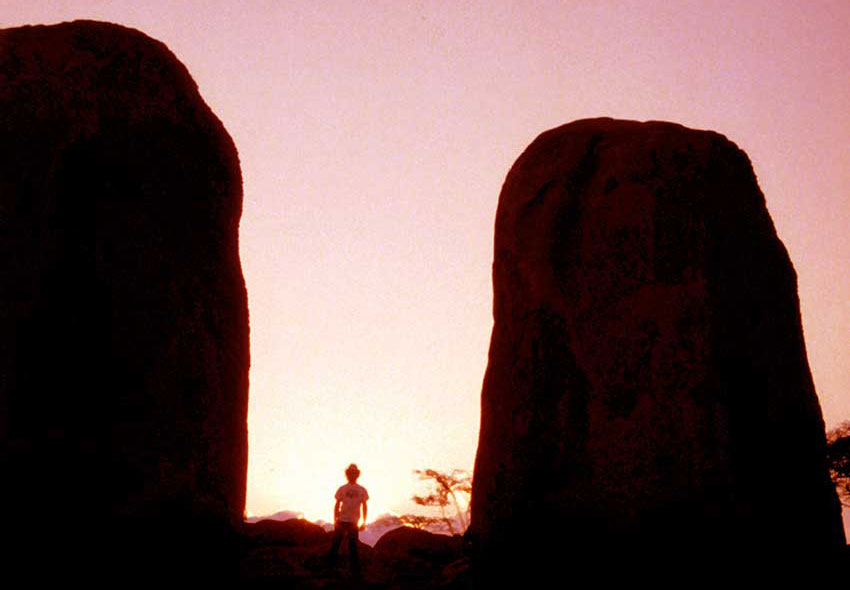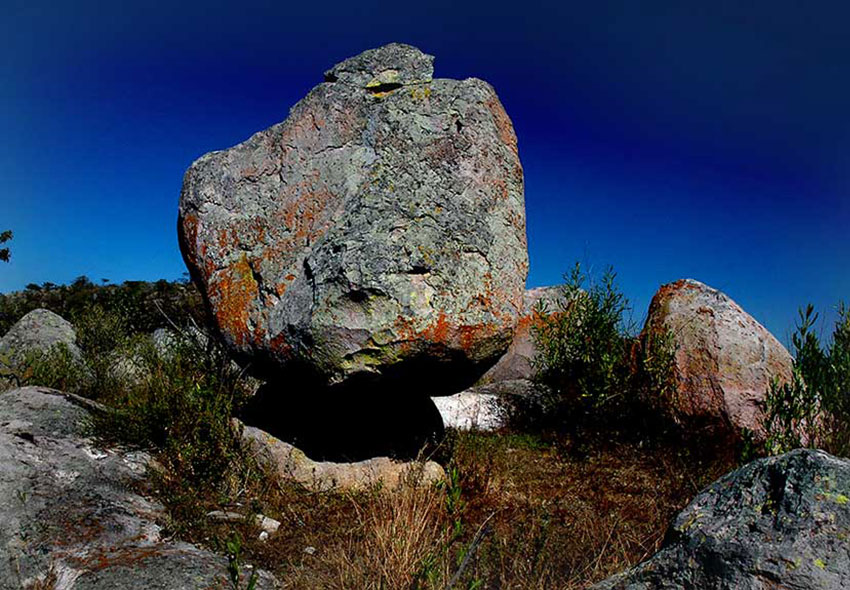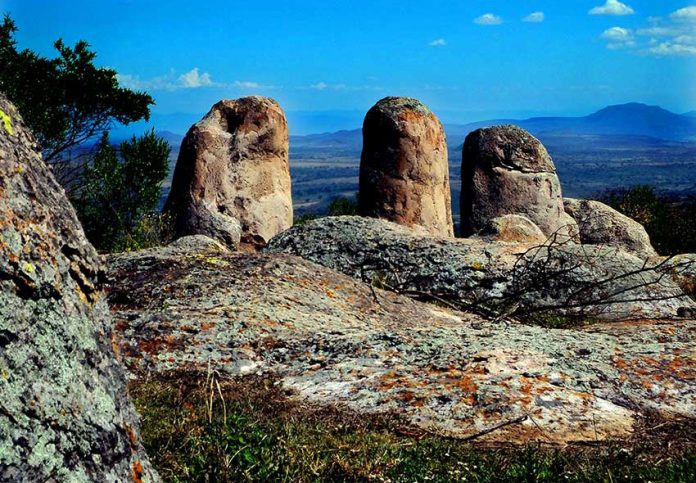An army of tall monoliths stands guard over the small town of Cuautla, Jalisco, located 115 kilometers southwest of Guadalajara. The word Cuautla means “the place where the eagles land,” and the overlooking mountain is called Las Águilas.
Many years ago, a determined citizen of Cuautla, Señor Miguel Mora, was captivated by those curious standing rocks and succeeded in drawing the attention of the Mexican press and the scientific community. I don’t know whether the monoliths are the remnants of a new-world Stonehenge (as one magazine has suggested) or just another awe inspiring work of nature, but it will always have a high place on my list of great places for hiking.
I was told that Las Águilas had once been an ancient center for astrology and magic, and that on certain days of the year, the rays of the rising sun pass through two monoliths, lighting up a curiously shaped “marker stone.” I also heard that Carlos Castaneda referred to this place as “a power center.”
An astronomer in Guadalajara told me that May 21 or 22, when the sun reaches its zenith over Las Águilas, would be a good time to check the place out for anything unusual at sunrise. So I proposed to my wife that we should camp out at Las Águilas, get up early, and see what we could discover.
The rock-covered hill is visible from a long distance, but when you get within a kilometer of it, you must park and continue on foot. Since this parking spot is flat and grassy, here is where we pitched our tent.

So inspired were we by the beautiful view of the hills covered with strangely shaped rocks, that we took little notice of the cows and bulls grazing all around us. But that night we discovered that these creatures apparently never sleep. Ominous footsteps outside our tent and heavy breathing only inches from our heads woke us at midnight.
Shining our flashlights in their eyes did not scare them away at all, but actually seemed to attract even more visitors! Shouting “¡Vayanse!” (Scram!) turned out to be equally ineffective. Ignoring them and trying to sleep proved impossible. We considered them friendly, not aggressive, but in our imaginations we could see the results of “one small step” in the wrong direction by “one big hoof,” and that thought was unnerving.
Finally we had no choice but to abandon ship and seek refuge in our truck which, for the duration of the night, was shaken by the bulls’ cornazos (“horny collisions”) as they relentlessly attempted to get at the garbage we had unwisely stowed beneath our vehicle.
Bleary-eyed, we rose at 5:00 p.m., trudged half an hour up the trail and positioned our tripod to catch the first rays of light. What we witnessed was indeed spectacular. The red disk of the sun rose straight up from the bottom of a gigantic V formed by the slanted tops of two of the monoliths, leaving the marker rock (shaped like a snowball stuck on a pyramid) standing alone in the center of the long, V-shaped shadow.
Not having really expected to see anything, we were very impressed. It seemed unlikely that such a grandiose illumination of the marker rock on that particular day of the year could be just a coincidence.
We returned to Las Águilas a few years later. Under the guidance of a local boy named Manuel Rangel — nicknamed Maico because he was crazy about Michael Jackson — we visited several nearby hilltops. As we walked along, we chatted in English, which Maico had learned from an American teacher in Cuautla. “I want to master two languages,” he told me: “English and Arabic.”

I told him he was definitely not a typical small-town boy and that, if he wanted, I could teach him a few words of Arabic, having spent 13 years of my life in Saudi Arabia. His eyes lit up: “How do you say, ‘hello,’ ‘thank you,’ ‘I,’ ‘you,’ ‘he?’ … well there was no end to what Maico wanted to learn and by the time we finished our visit, he had nicely memorized a long list of expressions and numbers.
Maico took us first to a site supposedly dedicated to magic, a hilltop we had not visited before. It was virtually covered with a thick forest of rocks: rocks shaped like bathtubs or sphinxes, balanced rocks, rocks as tall as pinnacles. It was a place where you could truly unlimber the imagination!
Hidden among all those rocks was a shelter cave, the subject of the usual stories about fabulous treasure hidden within. Though it was getting late, we still had time to take a look at one more hill which, Maico claimed, had been dedicated to religious ceremonies. Here we found a long, oval-shaped mound which looked like it ought to be archaeologically important. This is the highest spot in the area (altitude 1,870 meters), with a truly magnificent lookout point. It’s also the only place we saw petroglyphs, but these engravings were so old and faint that we could hardly make them out.
Time passed and one day I asked myself: Whatever happened to Las Águilas?
A few months ago, Guadalajara muralist Jorge Monroy and I decided it was time to go have a look.
Since Las Águilas had been reported on in numerous magazines and newspapers, we expected to find a neon sign advertising it somewhere along the highway near Cuautla, but we saw nothing. “I guess we’ll have to follow the track I recorded 13 years ago,” I told Jorge, pulling out my GPS.
[soliloquy id="110247"]
The old track took us along dirt roads for half a kilómeter and brought us to the grassy parking spot where my wife and I had lost our battle with horned giants many years ago.
We parked and began hiking along a narrow trail skirting a picturesque little lake.
Just beyond the lake, the trail led us straight to a big, beautiful and utterly abandoned “Las Águilas Visitors’ Center.” This was a surprise and so was the wide, well-made cobblestone andador (sidewalk) which took us on a one-kilometer walk up to the fabled Mexican Stonehenge. Along the way we found streetlamps as well as benches where you could take a breather as you climb 75 meters in altitude.
At the top of the hill, the monoliths still looked the same, not commercialized in any manner, still hiding their ancient secrets. At the cliff edge a roofed belvedere had been built, offering an excellent view of the surrounding countryside.
Later that day we were able to meet with Miguel Mora’s nephew Jorge, who is now director of tourism in Cuautla. We congratulated him on getting the walkway built. “But,” we asked him, “why is there no road leading from the highway to the visitors’ center?”
“We had plans and funds to build it,” he replied, “but once tourists started showing up at the monoliths, the local landowners decided they didn’t like visitors after all. So Phase II of the development plan was never carried out and only occasional hiker types like you two ever go up there.”
What the local ejido (country cooperative) knew jived with my own discovery years ago. In Mexico, if you want to keep visitors down to a mere handful, just locate your parking space more than half a kilometer from the attraction. So, whatever secrets Las Águilas harbors are still as safe as ever, but if you like to walk, the Mexican Stonehenge still welcomes you.
To visit Las Águilas, either consult my map on Wikiloc or go to the plaza at Cuautla and shout “Maico!”
The writer has lived near Guadalajara, Jalisco, for more than 30 years and is the author of A Guide to West Mexico’s Guachimontones and Surrounding Area and co-author of Outdoors in Western Mexico. More of his writing can be found on his website.
